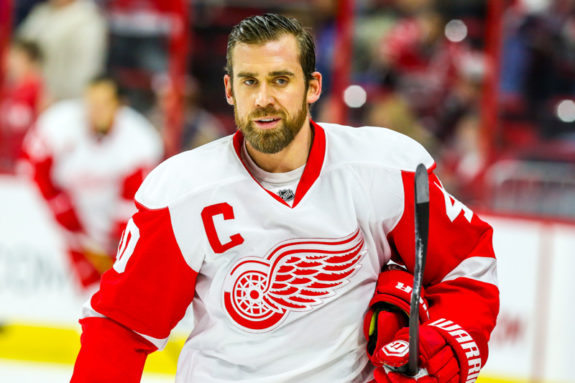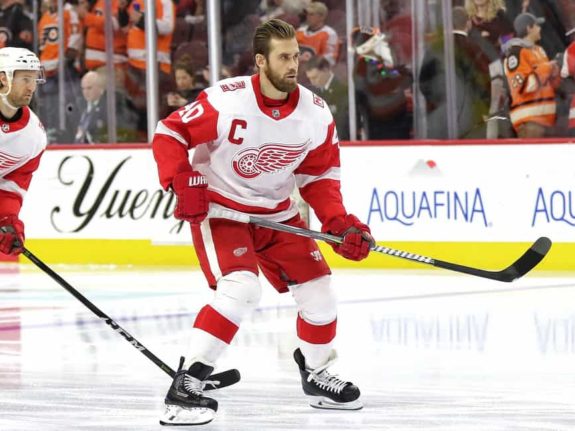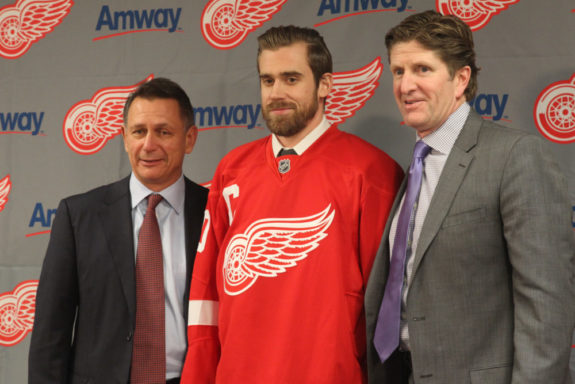From 2013 to 2018, Henrik Zetterberg served as the captain of the Detroit Red Wings. His leadership, coupled with his unrelenting drive to perform at the highest level, have cemented him in the organization’s history books as a captain willing to give his all for his team. Today, we’ll be taking a look at Zetterberg’s career: from unlikely beginnings to unbelievable moments to his one-of-a-kind legacy as a leader on and off the ice.
Zetterberg’s Humble Beginnings
Zetterberg was drafted 210th overall by the Red Wings in the seventh round of the 1999 NHL Entry Draft. He caught the attention of assistant general manager Jim Nill and director of European scouting Håkan Andersson during a tournament in Finland. In an interview, Nill remarked that all he noticed during the tournament was, “this little Zetterberg guy who always had the puck.” With nothing to lose in the seventh round, the Red Wings decided to make him a low-risk, high-reward pick.
Neither Nill nor Anderson — nor even Zetterberg — knew what would unfold.

After spending two years developing his game playing for Timrå IK in the Swedish league, he signed his entry-level contract in 2002, playing his first NHL game in the 2002-03 season. He scored 22 goals and 22 assists in 79 games that season, leading all first-year players. An injury-shortened year in 2003-04 saw him nearly match his point totals in fewer games. After the lockout-shortened season in 2004-05, he accepted the role as an alternate captain after the retirement of Steve Yzerman. Soon after, Zetterberg was placed on a line with Pavel Datsyuk. From that point on, the league was never the same.
The Birth of the Eurotwins
Building chemistry in hockey tends to take time for players to each other’s habits, mannerisms, and shortcomings. Timing, however, was never an issue for Datsyuk and Zetterberg, popularly known as the “Eurotwins” due to their almost telepathic connection. Whenever the duo set foot on the ice, teams would exhaust themselves trying to outsmart them. During the 2007-08 season, both players reached career highs, with Zetterberg scoring 43 goals and 92 points in just 75 games and Datsyuk scoring 31 goals and 97 points.
While Zetterberg shouldered the play-making responsibilities, Datsyuk positioned himself for a breakout pass or a opening that he could capitalize on. When partnered with Tomas Holmstrom, Zetterberg’s play-making, Datsyuk’s positioning, and Holmstrom’s finishing ability made for a deadly one-two-three punch. The Eurotwins played a combined 13 seasons together, appearing in the playoffs in all 13 seasons. They won the Cup in 2008.
“When I watch Pavel Datsyuk play, all I think about is how much will he has and how determined he is. When I watch Zetterberg he’s the energizer bunny. He just keeps coming. He doesn’t care who it is or who he’s playing.”
Mike Babcock, former head coach of the Detroit Red Wings
The Conn Smythe Shift
Zetterberg’s most impressive feat in the 2008 Stanley Cup Final against the Pittsburgh Penguins. During Game 4, two penalties put the Penguins on a 5-on-3 power play. For the next 1:26, Zetterberg gave his absolute all on the ice, becoming a defensive stalwart in the face of the Penguins’ deadliest players. His most notable play was the key moment he tied up Penguins captain Sidney Crosby’s stick, preventing a tip-in goal that would have secured the Penguins the game.
During that shift, the crowd began to chant, filling the arena with “MVP! MVP!” as Zetterberg gave it his all on the ice. The team won the game 2-1. Their decisive victory helped push the team to their Cup victory in Game 6, when Zetterberg scored an incredible game-winning goal. His self-sacrificial shift, combined with an explosive 27 points in just 22 games, earned him the Conn Smythe Trophy. His 27 points is still a Red Wings record for the most amount of points scored by a player in one postseason.
The End of an Era
Back injuries began to shorten several of his seasons towards the end of his career. In 2012-13 and 2013-14, Zetterberg was sidelined for the majority of both seasons, preventing his participation in the playoffs and cutting his time at the 2014 Sochi Olympics short. When rival captain Zdeno Charahelped Zetterberg with his bags at the Olympics, it was clear that his back issues weren’t going away.

For the sake of his health, Zetterberg opted to retire from the NHL at the end of the 2017-18 season. Despite the fact that he was able to play all 82 games of his last three seasons, his degenerative back condition and his age caught up with him. Shortly following his retirement, Zetterberg revealed the graveness of his injury; he had been battling back pain for the last five years. Retirement was the only option.
He played 1,082 games for the Red Wings, scoring 337 goals and 960 points. He still ranks fifth in goals and points in Red Wings franchise history and he holds the Red Wings’ record for the longest point streak in a regular season (17 points in 17 games) and the most points in a single playoff season (27).
Zetterberg’s Legacy
Zetterberg was one of four players from the 1999 Draft to reach 1,000 career games, joining Daniel and Henrik Sedin (who were taken second and third overall) and Radim Vrbata. He’s a member of the Triple Gold Club as one of 29 players to have won a Stanley Cup, an Olympic Gold medal, and a World Championship gold medal. Along with the Conn Smythe Trophy, he won the King Clancy Memorial Trophy in 2015 for his unparalleled leadership on the ice.
Jeff Blashill, head coach of the Detroit Red Wings
He’s just got a burning desire to be great. That burning desire took him from a late-round draft pick to one of the best two-way centers of his generation.”
His impact on the Red Wings’ roster is still felt to this day. Players like Dylan Larkin and Anthony Mantha frequently cite Zetterberg as integral to their development as players. Larkin has molded his playing style after Zetterberg, prioritizing a 200-foot game above all else. Through the good times and bad, he handled the media’s toughest questions as the face of the organization.

When Zetterberg retired, he left an irreplaceable void that will be felt for years to come. His leadership, skill, and unrelenting willpower made him the face of the Red Wings for nearly a decade. Years from now, players will refer to him as one of their key role models. He’s a player, a leader, and an unforgettable icon in Red Wings history.